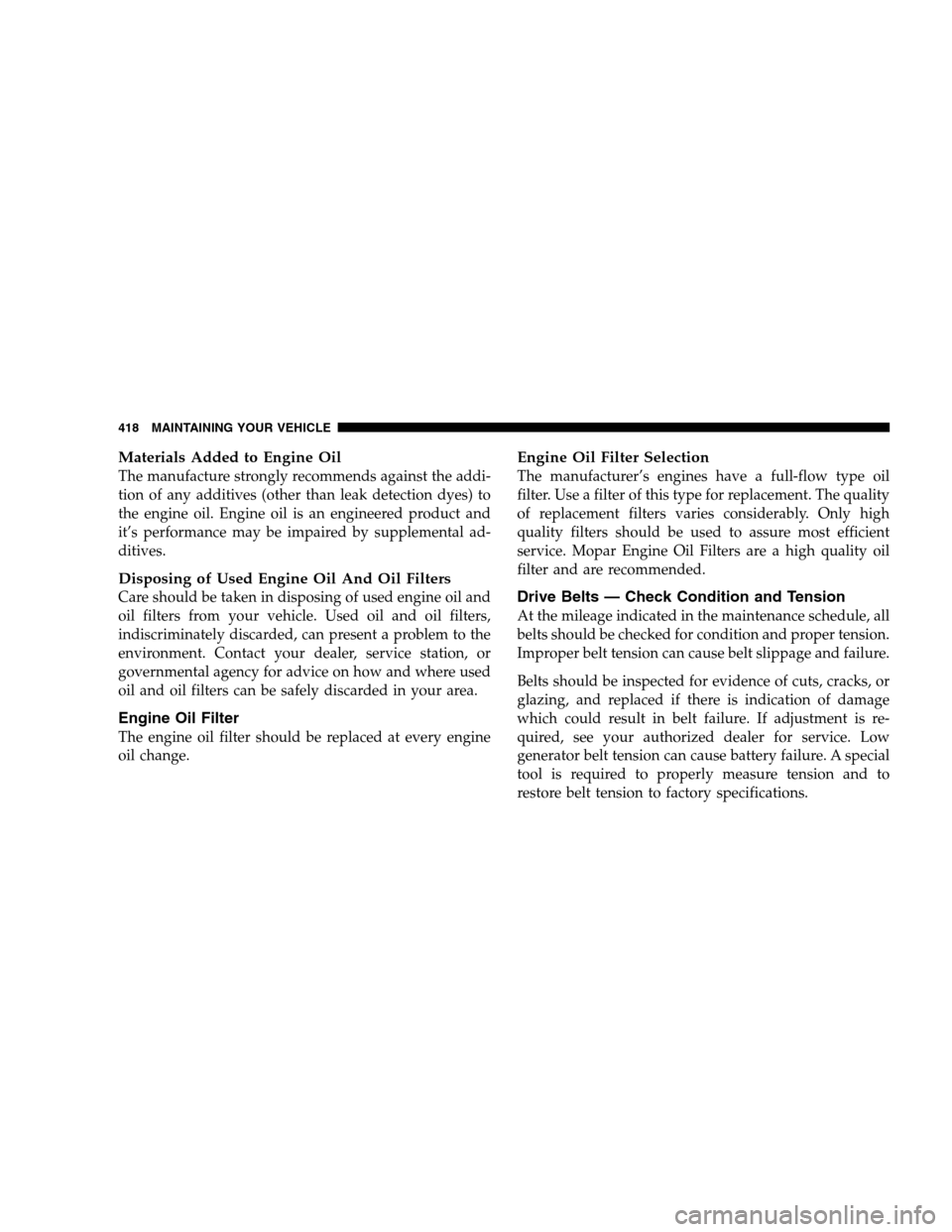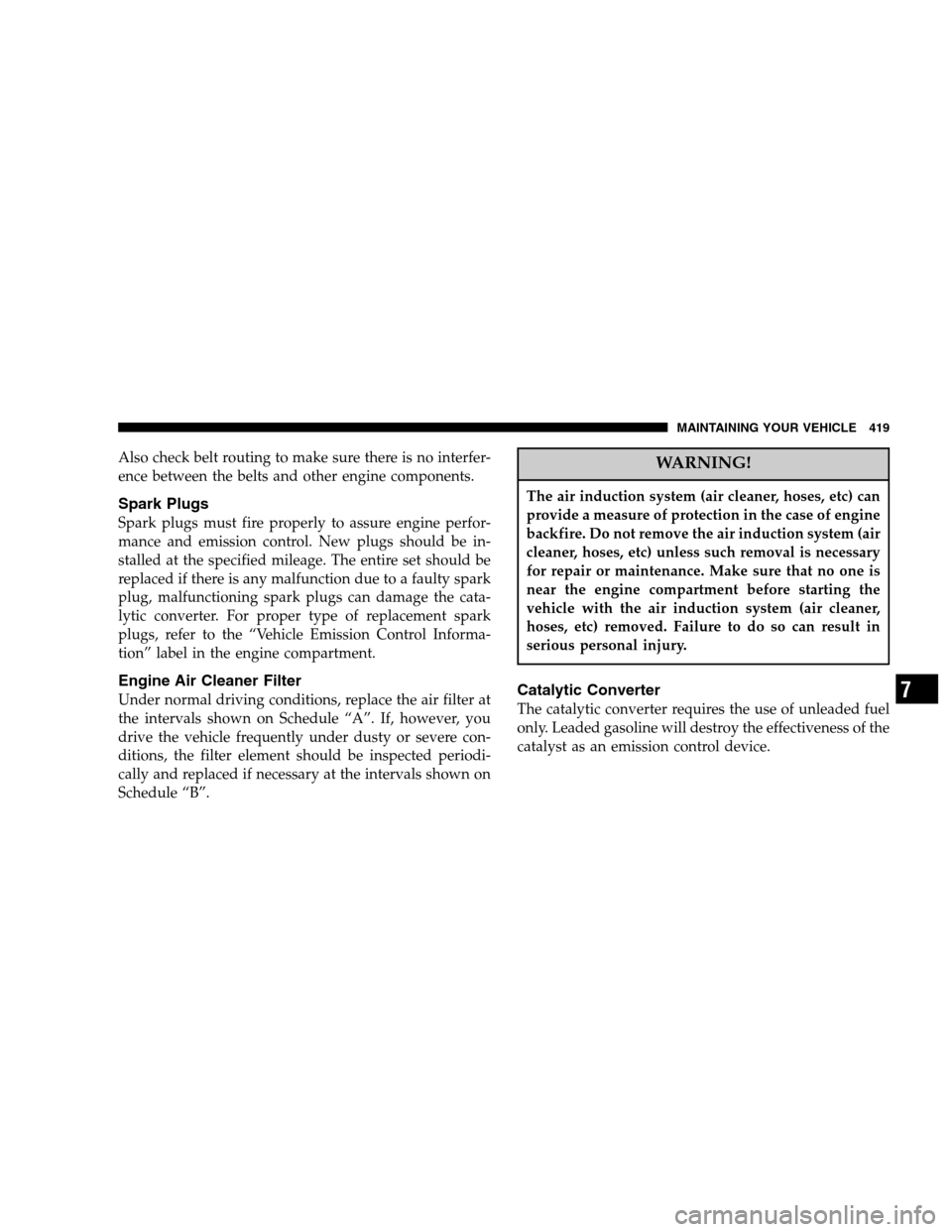Page 403 of 504

WARNING!
Do not connect the cable to the negative post of the
discharge battery. The resulting electrical spark
could cause the battery to explode.
During cold weather when temperatures are below
freezing point, electrolyte in a discharged battery
may freeze. Do not attempt jump starting because
the battery could rupture or explode. The battery
temperature must be brought up above freezing
point before attempting jump start.
6. Start the engine in the vehicle which has the booster
battery, let the engine idle a few minutes, then start the
engine in the vehicle with the discharged battery.
7. When removing the jumper cables, reverse the above
sequence exactly. Be careful of the moving belts and fan.
WARNING!
Any procedure other than above could result in:
1. Personal injury caused by electrolyte squirting
out the battery vent;
2. Personal injury or property damage due to battery
explosion;
3. Damage to charging system of booster vehicle or
of immobilized vehicle.
FREEING A STUCK VEHICLE
If your vehicle becomes stuck in mud, sand or snow, it
can often be moved by a rocking motion. Turn your
steering wheel right and left to clear the area around the
front wheels. Then shift back and forth between Reverse
and Drive. Usually the least accelerator pedal pressure to
maintain the rocking motion without spinning the
wheels is most effective.
WHAT TO DO IN EMERGENCIES 403
6
Page 407 of 504
MAINTAINING YOUR VEHICLE
CONTENTS
�3.3L/3.8L Engines......................410
�Onboard Diagnostic System — OBD II........411
▫Loose Fuel Filler Cap Message............411
�Emissions Inspection And Maintenance
Programs............................412
�Replacement Parts......................413
�Dealer Service.........................414
�Maintenance Procedures..................414
▫Engine Oil..........................414▫Engine Oil Filter......................418
▫Drive Belts — Check Condition And Tension . . 418
▫Spark Plugs.........................419
▫Engine Air Cleaner Filter................419
▫Catalytic Converter....................419
▫Maintenance-Free Battery................421
▫Air Conditioner Maintenance.............423
▫Power Steering — Fluid Check............424
▫Front Suspension Ball Joints..............425
7
Page 418 of 504

Materials Added to Engine Oil
The manufacture strongly recommends against the addi-
tion of any additives (other than leak detection dyes) to
the engine oil. Engine oil is an engineered product and
it’s performance may be impaired by supplemental ad-
ditives.
Disposing of Used Engine Oil And Oil Filters
Care should be taken in disposing of used engine oil and
oil filters from your vehicle. Used oil and oil filters,
indiscriminately discarded, can present a problem to the
environment. Contact your dealer, service station, or
governmental agency for advice on how and where used
oil and oil filters can be safely discarded in your area.
Engine Oil Filter
The engine oil filter should be replaced at every engine
oil change.
Engine Oil Filter Selection
The manufacturer’s engines have a full-flow type oil
filter. Use a filter of this type for replacement. The quality
of replacement filters varies considerably. Only high
quality filters should be used to assure most efficient
service. Mopar Engine Oil Filters are a high quality oil
filter and are recommended.
Drive Belts — Check Condition and Tension
At the mileage indicated in the maintenance schedule, all
belts should be checked for condition and proper tension.
Improper belt tension can cause belt slippage and failure.
Belts should be inspected for evidence of cuts, cracks, or
glazing, and replaced if there is indication of damage
which could result in belt failure. If adjustment is re-
quired, see your authorized dealer for service. Low
generator belt tension can cause battery failure. A special
tool is required to properly measure tension and to
restore belt tension to factory specifications.
418 MAINTAINING YOUR VEHICLE
Page 419 of 504

Also check belt routing to make sure there is no interfer-
ence between the belts and other engine components.
Spark Plugs
Spark plugs must fire properly to assure engine perfor-
mance and emission control. New plugs should be in-
stalled at the specified mileage. The entire set should be
replaced if there is any malfunction due to a faulty spark
plug, malfunctioning spark plugs can damage the cata-
lytic converter. For proper type of replacement spark
plugs, refer to the “Vehicle Emission Control Informa-
tion” label in the engine compartment.
Engine Air Cleaner Filter
Under normal driving conditions, replace the air filter at
the intervals shown on Schedule “A”. If, however, you
drive the vehicle frequently under dusty or severe con-
ditions, the filter element should be inspected periodi-
cally and replaced if necessary at the intervals shown on
Schedule “B”.
WARNING!
The air induction system (air cleaner, hoses, etc) can
provide a measure of protection in the case of engine
backfire. Do not remove the air induction system (air
cleaner, hoses, etc) unless such removal is necessary
for repair or maintenance. Make sure that no one is
near the engine compartment before starting the
vehicle with the air induction system (air cleaner,
hoses, etc) removed. Failure to do so can result in
serious personal injury.
Catalytic Converter
The catalytic converter requires the use of unleaded fuel
only. Leaded gasoline will destroy the effectiveness of the
catalyst as an emission control device.
MAINTAINING YOUR VEHICLE 419
7
Page 423 of 504
Air Conditioner Maintenance
For best possible performance, your air conditioner
should be checked and serviced by an Authorized Dealer
at the start of each warm season. This service should
include cleaning of the condenser fins and a system
performance check. Drive belt tension should also be
checked at this time.WARNING!
•Use only refrigerants and compressor lubricants
approved by the manufacturer for your air condi-
tioning system. Some unapproved refrigerants are
flammable and can explode, injuring you. Other
unapproved refrigerants or lubricants can cause
the system to fail, requiring costly repairs. Refer
to Section 3 of the Warranty Information book for
further warranty information.
•The air conditioning system contains refrigerant
under high pressure. To avoid risk of personal
injury or damage to the system, adding refrigerant
or any repair requiring lines to be disconnected
should be done by an experienced repairman.
MAINTAINING YOUR VEHICLE 423
7
Page 446 of 504

Cleaning Plastic Instrument Cluster Lenses
The lenses in front of the instruments in this vehicle are
molded in clear plastic. When cleaning the lenses, care
must be taken to avoid scratching the plastic.
1. Clean with a wet soft rag. A mild soap solution may be
used, but do not use high alcohol content or abrasive
cleaners. If soap is used, wipe clean with a clean damp
rag.
2. Dry with a soft tissue.
Seat Belt Maintenance
Do not bleach, dye or clean the belts with chemical
solvents or abrasive cleaners. This will weaken the fabric.
Sun damage can also weaken the fabric.
If the belts need cleaning, use a mild soap solution or
lukewarm water. Do not remove the belts from the car to
wash them.Replace the belts if they appear frayed or worn or if the
buckles do not work properly.
Cleaning The Instrument Panel and Underseat
Cup Holders
Removal
Remove the ash receiver from the convenience tray if
there is a smoker’s package in your vehicle. With your
index finger, locate the stop tab located at the rear of the
convenience tray.
446 MAINTAINING YOUR VEHICLE
Page 467 of 504
Miles 57, 000 60, 000 63, 000 66, 000 69, 000 72, 000
(Kilometers) (95 000) (100 000) (105 000) (110 000) (115 000) (120 000)
Change engine oil and engine oil filter.XXXXX X
Rotate TiresXX X
Inspect the brake linings.XX
Inspect the engine air cleaner filter, replace if
necessary.X XXX X
Replace theengine air cleaner filter. X
Inspect the tie rod ends and boot seals.X
Inspect thePCV valveand replace if neces-
sary.X
Inspect the serpentine drive belt on 3.3 liter
and 3.8 liter engines, replace if necessary. ‡X
Change the automatic transmission fluid and
filter.�X
Replace the air conditioning filter.XX
SCHEDULE “B” 467
8
M
A
I
N
T
E
N
A
N
C
E
S
C
H
E
D
U
L
E
S
Page 468 of 504
Miles 75, 000 78, 000 81, 000 84, 000 87, 000 90, 000
(Kilometers) (125 000) (130 000) (135 000) (140 000) (145 000) (150 000)
Change engine oil and engine oil filter.XXXXX X
Rotate TiresXX X
Inspect the brake linings.XX
Inspect the engine air cleaner filter, replace if
necessary.XXXX
Replace theengine air cleaner filter X X
Inspect the serpentine drive belt on 3.3 liter
and 3.8 liter engines, replace if necessary. ‡XX
Inspect the tie rod ends and boot seals.X
Check thePCV valveand replace if necessary.
Not required if previously changed.X
Replace the air conditioning filter.X
468 SCHEDULE “B”
8
M
A
I
N
T
E
N
A
N
C
E
S
C
H
E
D
U
L
E
S